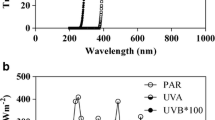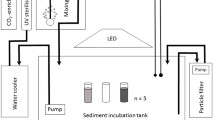Abstract
Increased anthropogenic emissions of carbon dioxide (CO2) have resulted in ocean acidification (OA) that is intertwined with enhanced ocean stratification. Diatoms are assumed to suffer from a more nutrient-limited condition in the future ocean. This study aimed to explore how OA affects the diatom dynamics under nutrient-poor conditions and the ability of diatoms to perceive nutrients (nitrogen, phosphorus, silicon, and trace metals) and cadmium (Cd) stimuli and assimilate nitrogen when receiving nutrients or Cd supplementation. Our study observed that diatom population grown under OA condition declined faster than those grown under ambient condition. Ocean acidification greatly lower intracellular Ca2+ concentration in diatom cells. Intracellular Ca2+ burst was involved in phosphorus accumulation but not in nitrogen, silicon, essential metals, and cadmium uptake. Our data demonstrate slower NO3– assimilation rates of diatoms grown in acidified seawater. Our study also indicates that diatoms have a poor perception of phosphorus availability under OA condition.



Similar content being viewed by others
References
Byrne RH (2002) Inorganic speciation of dissolved elements in seawater: the influence of pH on concentration ratios. Geochem Trans 3(2):11–16
Coma R, Ribes M, Serrano E, Jimenez E, Salat J, Pascual J (2009) Global warming-enhanced stratification and mass mortality events in the Mediterranean. Proc Natl Acad Sci USA 106(15):6176–6181
Dodd AN, Kudla J, Sanders D (2010) The language of calcium signaling. Annu Rev Plant Biol 61:593–620
Doney SC, Fabry VJ, Feely RA, Kleypas JA (2009) Ocean acidification: the other CO2 problem. Ann Rev Mar Sci 1:169–192
Dong F, Wang P, Qian W, Tang X, Zhu X, Wang Z, Cai Z, Wang J (2020) Mitigation effects of CO2-driven ocean acidification on cd toxicity to the marine diatom Skeletonema costatum. Environ Pollut 259:113850
Falciatore A, Alacala MR, Croot P, Bowler C (2000) Perception of environmental signals by a marine diatom. Science 288:2363–2366
Gao K, Beardall J, Hader DP, Hall-Spencer JM, Gao G, Hutchins DA (2019) Effects of ocean acidification on marine photosynthetic organisms under the concurrent influences of warming, UV radiation, and deoxygenation. Front Mar Sci 6:1–18
Gao K, Gao G, Wang Y, Dupont S (2020) Impacts of ocean acidification under multiple stressors on typical organisms and ecological processes. Mar Life Sci & Technol 2:279–291
Geesey GG, Wigglesworth-Cooksey B, Cooksey KE (2000) Influence of calcium and other cations on surface adhesion of bacteria and diatoms: a review. Biofouling 15(1–3):195–205
Grasshoff K, Kremling K, Ehrhardt M (2009) Methods of seawater analysis. John Wiley & Sons
Guillard RR, Ryther JH (1962) Studies of marine planktonic diatoms: I. Cyclotellanana Hustedt, and Detonula confervacea (Cleve). Gran Can J Microbiol 8(2):229–239
Guinotte JM, Fabry VJ (2008) Ocean acidification and its potential effects on marine ecosystems. Ann NY Acad Sci 1134:320–342
Helliwell KE, Harrison EL, Christie-Oleza JA, Rees AP, Kleiner FH, Gaikwad T, Downe J, Aguilo-Ferretjans MM, AI-Moosawi L, Brownlee C, Wheeler GL (2021) A novel Ca2+ signaling pathway coordinates environmental phosphorus sensing and nitrogen metabolism in marine diatoms. Curr Biol 31(5):978–989
Marella TK, Saxena A, Tiwari A (2020) Diatom mediated heavy metal remediation: a review. Bioresour Technol 305:123068
Kudla J, Batistič O, Hashimoto K (2010) Calcium signals: the lead currency of plant information processing. Plant Cell 22(3):541–563
Shi D, Xu Y, Hopkinson BM, Morel FM (2010) Effect of ocean acidification on iron availability to marine phytoplankton. Science 327:676–679
Shi D, Hong H, Su X, Liao L, Chang S, Lin W (2019) The physiological response of marine diatoms to ocean acidification: differential roles of seawater pCO2 and pH. J Phycol 55(3):521–533
Tantanasarit C, Englande AJ, Babel S (2013) Nitrogen, phosphorus and silicon uptake kinetics by marine diatom Chaetoceros calcitrans under high nutrient concentrations. J Exp Mar Bio Ecol 446:67–75
Thor K (2019) Calcium—nutrient and messenger. Front Plant Sci 10:440
Undurraga SF, Ibarra-Henriquez C, Fredes I, Alvarez JM, Gutierrez RA (2017) Nitrate signaling and early responses in Arabidopsis roots. J Exp Bot 68(10):2541–2551
Wang W, Dei CH (2001) Effect of major nutrient additions on metal uptake in phytoplankton. Environ Pollut 111(2):233–240
Waser NAD, Harrison PJ, Nielsen B, Calvert SE (1998) Nitrogen isotope fractionation during the uptake and assimilation of nitrate, nitrite, ammonium, and urea by a marine diatom. Limnol Oceanogr 43(2):215–224
Williamson RE, Ashley CC (1982) Free Ca2+ and cytoplasmic streaming in the alga Chara. Nature 296:647–651
Wu Y, Gao K, Riebesell U (2010) CO2-induced seawater acidification affects physiological performance of the marine diatom Phaeodactylum tricornutum. Biogeosciences 7(9):2915–2923
Xu Y, Shi D, Aristilde L, Morel FM (2012) The effect of pH on the uptake of zinc and cadmium in marine phytoplankton: possible role of weak complexes. Limnol Oceanogr 57(1):293–304
Xue HB, Stumm W, Sigg L (1988) The binding of heavy metals to algal surfaces. Water Res 22(7):917–926
Acknowledgements
This study was supported by The National Natural Science Foundation of China (41976140; U23A2048;42376152); Hong Kong Research Grants Council (16101622); The Guangxi Key R&D Program of China (GUIKE 20234B28005); Shenzhen Science and Technology Program (JCYJ20220531103015035); Special Program of Key Sectors in Guangdong Universities (2022ZDZX4040; 2023KCXTD028).
Author information
Authors and Affiliations
Corresponding authors
Ethics declarations
Competing Interest
The authors declare that they have no known competing financial interests or personal relationships that could have appeared to influence the work reported in this paper.
Additional information
Publisher’s Note
Springer Nature remains neutral with regard to jurisdictional claims in published maps and institutional affiliations.
Rights and permissions
Springer Nature or its licensor (e.g. a society or other partner) holds exclusive rights to this article under a publishing agreement with the author(s) or other rightsholder(s); author self-archiving of the accepted manuscript version of this article is solely governed by the terms of such publishing agreement and applicable law.
About this article
Cite this article
Zhang, Z., Pan, K. & Liu, H. Survival of Nutrient-Starved Diatoms Under Ocean Acidification: Perspective from Nutrient Sensing, Cadmium Detection, and Nitrogen Assimilation. Bull Environ Contam Toxicol 112, 21 (2024). https://doi.org/10.1007/s00128-023-03849-8
Received:
Accepted:
Published:
DOI: https://doi.org/10.1007/s00128-023-03849-8




